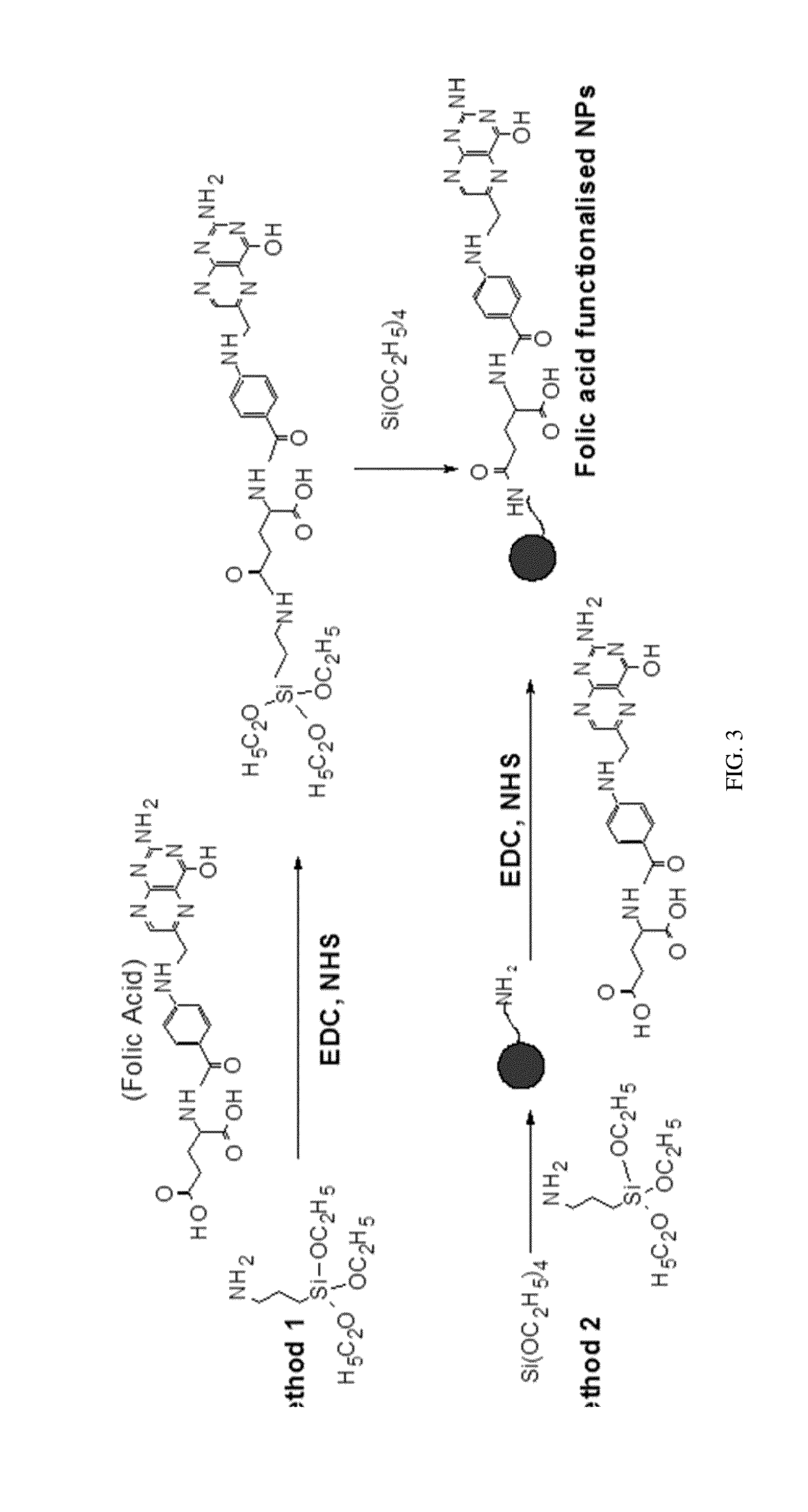Functionalized ultrabright fluorescent silica particles
a fluorescent silica nanoparticle and fluorescent dye technology, applied in the field of methods, can solve the problems of insufficient study of the behavior of fluorescent dyes in silica materials with well-defined cylindrical porosity, potential toxicity, and a significant fraction of non-fluorescent qds, and achieve the effect of not working with traditional functionalization methods
- Summary
- Abstract
- Description
- Claims
- Application Information
AI Technical Summary
Benefits of technology
Problems solved by technology
Method used
Image
Examples
example 1
Functionalization with Amine Groups on UFSPs
[0058]According to this embodiment, tetraethyl orthosilicate (TEOS, Aldrich), γ-aminoporpyltriethoxysilane (ATES, Aldrich), cetyltrimethylammonium chloride (CTAC, 25% aqueous solution, Aldrich), triethanolamine (TEA, Aldrich), folic acid (Aldrich), N-hydroxysuccinimide (NHS, Aldrich), 1-ethyl-3-(3-dimethylaminopropyl)carbodiimide (EDC, Aldrich) and Rhodamine 6G dye (Exciton Inc.) were used in this study. All the chemicals were used without further purification. Ultrapure deionized water from a Milli-Q system was used for all synthesis, dialysis, and storage steps. Dialysis membranes of molecular weight cutoff 15 kDa (Spectra / Por regenerated cellulose) were used in all dialysis steps.
[0059]Amino-modified silica precursor was prepared in the molar ratio 1TEOS (tetraethylorthosilicate):0.025 ATES (aminopropyltrimethoxysilane). The ATES was added to the reaction mixture containing tetraethylorthosilicate, triethanolamine, cetyltrimethylammoniu...
example 2
Further Functionalization with Folic Acid
[0061]This example demonstrates that carboxylic and amine modified UFSPs can be used to attach biomolecules while preserving the high brightness of the UFSPs. Folic acid is an example of such a molecule. Because folate receptors are overexpressed in the majority of epithelial cancers, this example has a direct practical application for prescreening of epithelial cancers.
[0062]A protocol for carbodiimide coupling was used to covalently attach folic acid molecules to the amine functionalized particles. Two methods of the attachment of folic acid molecules are described here. The outcome influences the brightness of the particles and extent of folic acid functionalisation. Method 1 provides particles with higher brightness. Method 2 yields particles with more folic acid functionalities. FIG. 3 shows a schematic of both methods 1 and 2.
[0063]Method 1
[0064]The folic acid functionalized UFSPs were synthesized using folic acid conjugated ATES. In a ...
example 3
Proof of Functionalization of UFSPs with Folic Acid by Using Cancer Cells Over-Expressed with Folic Acid Receptors
[0075]Human epithelial cervical cancer cell line derived from tumors was used to test bio-activity of the functionalized particles. The details of the cell preparation were described previously. The cells were cultured in two-welled Labtek slides. The cells were washed with phosphate buffered saline (PBS) prior to incubation with nanoparticles. The incubation was done with the particular nanoparticle suspension for 15 min, and then washed twice with phosphate buffered saline (PBS), and used for imaging. The concentration of the particles was 9.3×1010 particles / mL in PBS in all cell internalization experiments. Cancerous CXT-1, 2 and 7, precancerous CX 16-1, 16-2 and 18-3 cell lines and normal HCX-132, 162 and 397 strains were used here. For the imaging study, all cells were cultured in two-welled Lab-Tek slides (Thermoscientific). The cells were used for experiments when...
PUM
 Login to View More
Login to View More Abstract
Description
Claims
Application Information
 Login to View More
Login to View More - R&D
- Intellectual Property
- Life Sciences
- Materials
- Tech Scout
- Unparalleled Data Quality
- Higher Quality Content
- 60% Fewer Hallucinations
Browse by: Latest US Patents, China's latest patents, Technical Efficacy Thesaurus, Application Domain, Technology Topic, Popular Technical Reports.
© 2025 PatSnap. All rights reserved.Legal|Privacy policy|Modern Slavery Act Transparency Statement|Sitemap|About US| Contact US: help@patsnap.com



